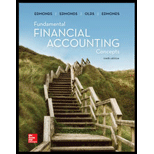
Fundamental Financial Accounting Concepts
10th Edition
ISBN: 9781259918186
Author: Thomas P Edmonds, Christopher Edmonds, Frances M McNair, Philip R Olds
Publisher: McGraw-Hill Education
expand_more
expand_more
format_list_bulleted
Question
Chapter 3, Problem 34BP
a.
To determine
Compute the debt-to-assets ratio and return-on-equity ratio for each company.
b.
To determine
Compute the percentage of assets financed by owner for each company.
c.
To determine
Identify the company that has the greatest level of financial risk and explain it.
d.
To determine
Identify the company that performed better from the perspective of the owners and explain it.
e.
To determine
Explain whether the given ratios support the concept of financial leverage.
Expert Solution & Answer
Want to see the full answer?
Check out a sample textbook solution
Students have asked these similar questions
Need answer
Solve this general accounting problem
Subject: general accounting
Chapter 3 Solutions
Fundamental Financial Accounting Concepts
Ch. 3 - Prob. 1QCh. 3 - Prob. 2QCh. 3 - Prob. 3QCh. 3 - Prob. 4QCh. 3 - Prob. 5QCh. 3 - Prob. 6QCh. 3 - Prob. 7QCh. 3 - Prob. 8QCh. 3 - Prob. 9QCh. 3 - Prob. 10Q
Ch. 3 - Prob. 11QCh. 3 - Prob. 12QCh. 3 - Prob. 13QCh. 3 - Prob. 14QCh. 3 - Prob. 15QCh. 3 - Prob. 16QCh. 3 - Prob. 17QCh. 3 - Prob. 18QCh. 3 - Prob. 19QCh. 3 - Prob. 20QCh. 3 - Prob. 21QCh. 3 - Prob. 22QCh. 3 - Prob. 1AECh. 3 - Prob. 2AECh. 3 - Prob. 3AECh. 3 - Prob. 4AECh. 3 - Prob. 5AECh. 3 - Prob. 6AECh. 3 - Prob. 7AECh. 3 - Prob. 8AECh. 3 - Prob. 9AECh. 3 - Prob. 10AECh. 3 - Prob. 11AECh. 3 - Prob. 12AECh. 3 - Prob. 13AECh. 3 - Prob. 14AECh. 3 - Prob. 15AECh. 3 - Prob. 16AECh. 3 - Prob. 17AECh. 3 - Prob. 18AECh. 3 - Prob. 19AECh. 3 - Prob. 20AECh. 3 - Prob. 21AECh. 3 - Prob. 22AECh. 3 - Prob. 23AECh. 3 - Prob. 24AECh. 3 - Prob. 25APCh. 3 - Prob. 26APCh. 3 - Prob. 27APCh. 3 - Prob. 28APCh. 3 - Prob. 29APCh. 3 - Prob. 30APCh. 3 - Prob. 31APCh. 3 - Prob. 32APCh. 3 - Prob. 33APCh. 3 - Prob. 34APCh. 3 - Prob. 35APCh. 3 - Prob. 36APCh. 3 - Prob. 1BECh. 3 - Prob. 2BECh. 3 - Prob. 3BECh. 3 - Prob. 4BECh. 3 - Prob. 5BECh. 3 - Prob. 6BECh. 3 - Prob. 7BECh. 3 - Prob. 8BECh. 3 - Prob. 9BECh. 3 - Prob. 10BECh. 3 - Prob. 11BECh. 3 - Prob. 12BECh. 3 - Prob. 13BECh. 3 - Prob. 14BECh. 3 - Prob. 15BECh. 3 - Prob. 16BECh. 3 - Prob. 17BECh. 3 - Prob. 18BECh. 3 - Prob. 19BECh. 3 - Prob. 20BECh. 3 - Prob. 21BECh. 3 - Prob. 22BECh. 3 - Prob. 23BECh. 3 - Prob. 24BECh. 3 - Prob. 25BPCh. 3 - Prob. 26BPCh. 3 - Prob. 27BPCh. 3 - Prob. 28BPCh. 3 - Prob. 29BPCh. 3 - Prob. 30BPCh. 3 - Prob. 31BPCh. 3 - Prob. 32BPCh. 3 - Prob. 33BPCh. 3 - Prob. 34BPCh. 3 - Prob. 35BPCh. 3 - Prob. 36BPCh. 3 - Prob. 1ATCCh. 3 - Prob. 3ATCCh. 3 - Prob. 4ATCCh. 3 - Prob. 5ATCCh. 3 - Prob. 6ATCCh. 3 - Prob. 7ATCCh. 3 - Prob. 9ATCCh. 3 - Prob. 10ATCCh. 3 - Prob. 1CP
Knowledge Booster
Similar questions
- Hello tutor please given General accounting question answer do fast and properly explain all answerarrow_forwardStevenson Manufacturing is planning to sell 450 storage bins and produce 420 bins during May. Each bin requires 600 grams of metal and 0.75 hours of direct labor. The metal costs $8 per 600 grams, and employees of the company are paid $16.50 per hour. Manufacturing overhead is applied at a rate of 120% of direct labor costs. Stevenson has 250 kilos of metal in the beginning inventory and wants to have 180 kilos in the ending inventory. How much is the total amount of budgeted direct labor cost for May?arrow_forwardprovide correct answerarrow_forward
- Management anticipates fixed costs of $65,000 and variable costs equal to 35% of sales. What will pretax income equal if sales are $320,000? Helparrow_forwardBefore prorating the manufacturing overhead costs at the end of 2016, the Cost of Goods Sold and Finished Goods Inventory had applied overhead costs of $59,700 and $54,000 in them, respectively. There was no Work-in-Process at the beginning or end of 2016. During the year, manufacturing overhead costs of $88,000 were actually incurred. The balance in the Applied Manufacturing Overhead was $94,500 at the end of 2016. If the under-or overapplied overhead is prorated between the Cost of Goods Sold and the inventory accounts, how much will be the Cost of Goods Sold after the proration? (rounded answer)arrow_forwardI want the correct answer with accounting questionarrow_forward
arrow_back_ios
SEE MORE QUESTIONS
arrow_forward_ios
Recommended textbooks for you

 AccountingAccountingISBN:9781337272094Author:WARREN, Carl S., Reeve, James M., Duchac, Jonathan E.Publisher:Cengage Learning,
AccountingAccountingISBN:9781337272094Author:WARREN, Carl S., Reeve, James M., Duchac, Jonathan E.Publisher:Cengage Learning, Accounting Information SystemsAccountingISBN:9781337619202Author:Hall, James A.Publisher:Cengage Learning,
Accounting Information SystemsAccountingISBN:9781337619202Author:Hall, James A.Publisher:Cengage Learning, Horngren's Cost Accounting: A Managerial Emphasis...AccountingISBN:9780134475585Author:Srikant M. Datar, Madhav V. RajanPublisher:PEARSON
Horngren's Cost Accounting: A Managerial Emphasis...AccountingISBN:9780134475585Author:Srikant M. Datar, Madhav V. RajanPublisher:PEARSON Intermediate AccountingAccountingISBN:9781259722660Author:J. David Spiceland, Mark W. Nelson, Wayne M ThomasPublisher:McGraw-Hill Education
Intermediate AccountingAccountingISBN:9781259722660Author:J. David Spiceland, Mark W. Nelson, Wayne M ThomasPublisher:McGraw-Hill Education Financial and Managerial AccountingAccountingISBN:9781259726705Author:John J Wild, Ken W. Shaw, Barbara Chiappetta Fundamental Accounting PrinciplesPublisher:McGraw-Hill Education
Financial and Managerial AccountingAccountingISBN:9781259726705Author:John J Wild, Ken W. Shaw, Barbara Chiappetta Fundamental Accounting PrinciplesPublisher:McGraw-Hill Education


Accounting
Accounting
ISBN:9781337272094
Author:WARREN, Carl S., Reeve, James M., Duchac, Jonathan E.
Publisher:Cengage Learning,

Accounting Information Systems
Accounting
ISBN:9781337619202
Author:Hall, James A.
Publisher:Cengage Learning,

Horngren's Cost Accounting: A Managerial Emphasis...
Accounting
ISBN:9780134475585
Author:Srikant M. Datar, Madhav V. Rajan
Publisher:PEARSON

Intermediate Accounting
Accounting
ISBN:9781259722660
Author:J. David Spiceland, Mark W. Nelson, Wayne M Thomas
Publisher:McGraw-Hill Education

Financial and Managerial Accounting
Accounting
ISBN:9781259726705
Author:John J Wild, Ken W. Shaw, Barbara Chiappetta Fundamental Accounting Principles
Publisher:McGraw-Hill Education